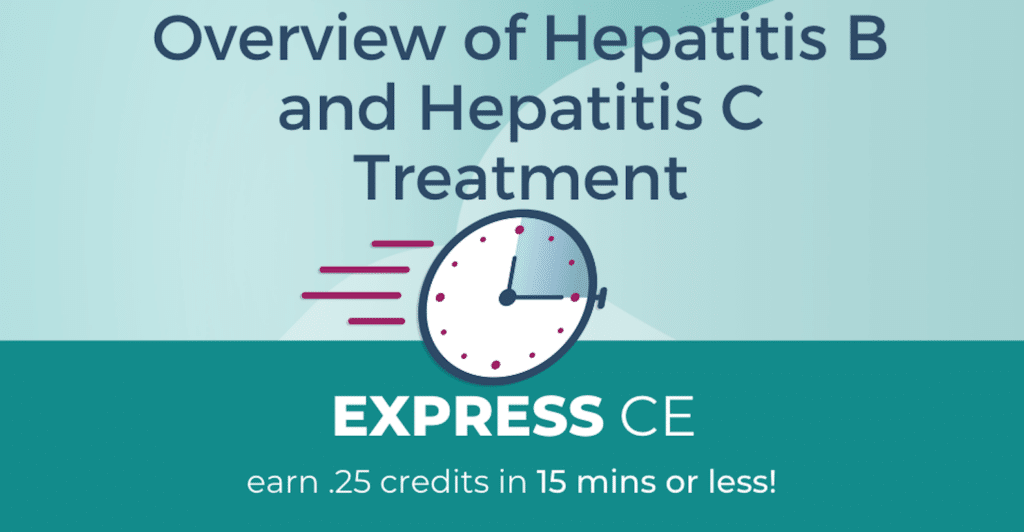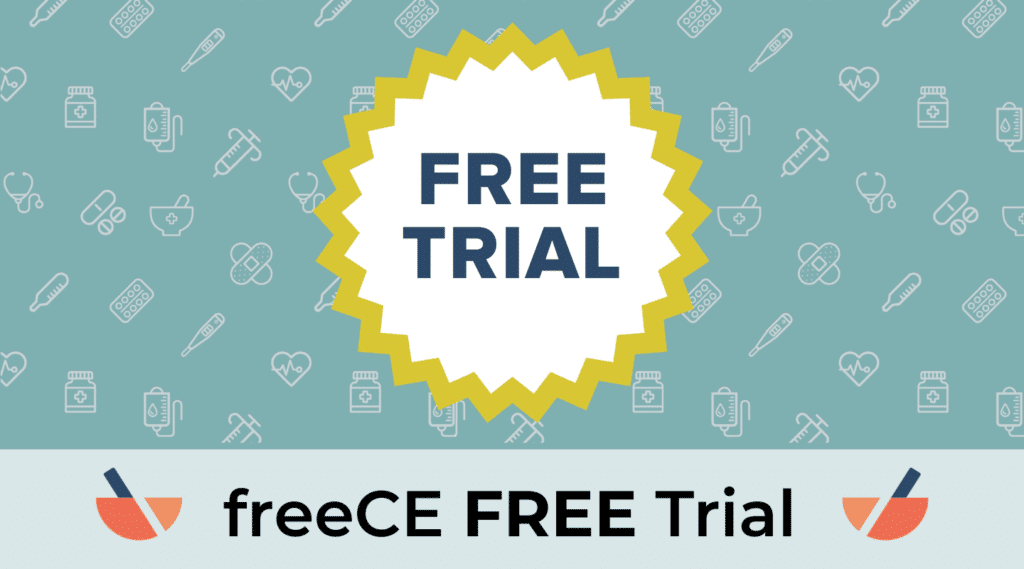Hepatitis-B rates have declined by 82% since 1990. For the unfortunate 18%, however, we can discuss drug therapy for treatment of Hepatitis-B. Of the chronically infected people, 15% to 25% of these patients develop chronic liver disease. This includes things like cirrhosis, liver failure, or liver cancer. freeCE offers MicroCE opportunities via our blog. We hope pharmacists and pharmacy technicians find value in this information.
Table of Contents
FIRST LINE TREATMENTS for Hepatitis B
Tenofovir disoproxil fumarate (Viread®)
NRTI for the treatment of HIV that has been available in the US for the treatment of HIV since 2001. This medication is also approved for HBV treatment since 2008. Resistance to this medication has yet to be identified.
- Mechanism of action: blocks HBV DNA polymerase – an enzyme that is necessary for the virus to replicate in liver cells.
- Pearl: Best option for Lamivudine resistance.
- Dose: 300mg once daily
- $1200/month
Tenofovir alafenamide (Vemlidy®)
Approved November 2016 and is indicated for the treatment of chronic hepatitis B virus infection in adults with compensated liver disease
- Mechanism of action: Like Viread®, Vemlidy® is also a nucleoside analog reverse transcriptase inhibitor
- Pearl: alafenamide salt is preferred if pregnant
- Dose: 25mg once daily.
- cost: $1100.00/month
- Treatment Duration:
- Hepatitis Be antigen (HBeAg) positive chronic hepatitis
- Treat ≥1 year until HBeAg seroconversion and undetectable serum HBV DNA
- Continue therapy for ≥6 months after HBeAg seroconversion
- HBeAg negative chronic hepatitis
- Treat >1 year until hepatitis B surface antigen (HBsAg) clearance
- Hepatitis Be antigen (HBeAg) positive chronic hepatitis
- Decompensated liver disease
- Lifelong treatment is recommended
- Advantages over Viread:
- Fewer adverse effects on bone density and renal function.
- Most patients should be switched from Viread to Vemlidy given the most favorable side effect profile.
- Vemlidy and Viread are similar in terms of efficacy, however, Vemlidy achieves similar results to Viread at a dose less than one-tenth that of Viread.
- Vemlidy has greater plasma stability, enabling it to deliver tenofovir to hepatocytes more efficiently.
- Renal dosing is not required for Vemlidy but is required for all other Hepatitis-B treatments.
- Here’s why: Systemic exposure to Tenofovir disoproxil fumarate (TDF) can cause nephrotoxicity and a decrease in bone mineral density. Unlike TDF, which is converted extensively in plasma to tenofovir, TAF activation occurs intra-cellularly.
- TAF 10 mg once daily produced circulating tenofovir levels that were 91% lower, BUT the intracellular levels were 4 times higherthan a dose of the TDF 300 mg.
- Here’s why: Systemic exposure to Tenofovir disoproxil fumarate (TDF) can cause nephrotoxicity and a decrease in bone mineral density. Unlike TDF, which is converted extensively in plasma to tenofovir, TAF activation occurs intra-cellularly.
Second Line Treatments
Seldomly used, but might be considered if cost is a concern.
1. Entecavir (Baraclude®)
FDA approved Dec 2005 for the treatment of adults with evidence of active viral replication and either evidence of persistent elevations in ALT or AST or histologically active disease. Has no activity against HIV.
- Mechanism of action:nucleoside analogue
- Pearls: entecavir should not be used for patients with lamivudine-resistant HBV because resistance has been observed in up to 50 percent of lamivudine-refractory patients after five years of treatment.
- Dosage: 0.5mg daily
- Give 1mg daily if Lamivudine resistant.
- Cost: Generic is $400/month and brand run $1400.00/month
- Adverse reactions
- BLACK BOX WARNING: lactic acidosis, hepatomegaly with steatosis
Neurological: Headache
Gastrointestinal: diarrhea, indigestion, and fatigue
- BLACK BOX WARNING: lactic acidosis, hepatomegaly with steatosis
2. Lamivudine (Epivir HBV®)
FDA approved in December 1998 for treatment of Hepatitis B infection, and HIV infection. It is also used for prevention of re-infection after transplantation for hepatitis B-induced cirrhosis
- Mechanism of action: inhibits both HBV DNA polymerase & HIV reverse transcriptase. Completely inhibits HBV polymerase at concentrations that have negligible effects on host DNA polymerase.
- Has intracellular half-life many hours longer than plasma half-life, which allows for infrequent dosing.
- Dosage: 100 mg/day
- Warnings/Precautions/Adverse Effects
- BLACK BOX WARNING: lactic acidosis, hepatomegaly with steatosis
- Neurological: Headache, insomnia, depressive disorders
- Gastrointestinal: Nausea, vomiting, diarrhea, anorexia
- Respiratory: Cough, nasal signs, and symptoms
- General: Malaise and fatigue, fever, and rash
- Drug Interactions
- Trimethoprim/Sulfamethoxazole increases Lamivudine AUC by approximately 44%, however no change in dose of either drug is recommended.
- Patient Information
- Must be followed under care of physician while on medication
- Not a cure for the disease
- Does not reduce transmission risk to other partners.
- Compliance is a must—do not miss any doses.
- May see redistribution of body fat.
- NOTE: dosage for HBV is 100 mg per day
- Mechanism of action: inhibits both HBV DNA polymerase & HIV reverse transcriptase. Completely inhibits HBV polymerase at concentrations that have negligible effects on host DNA polymerase.
- Dosage for HIV is: 300mg /day
- 150mg BID or 300mg QD
- Dosage for transplant is: 100 mg daily 4 weeks before transplant and continue for at least 12 months post-transplant
- Dosage for HIV is: 300mg /day
- This drug is well tolerated, but drug resistant mutations do occur.
- After 1 year – 15%, 2 years – 38%, 3 years – 56%, and 4 years – 67% resistance rates are seen.
3. Adefovir (Hepsera®)
FDA approved September 2002 for HBV –typically not recommended due to weak anti-viral activity.
- Mechanism: inhibits HBV DNA polymerase by competing with natural substrate deoxyadenosine triphosphate & causing DNA chain termination, after incorporation into viral DNA.
- Dosage: 10 mg a day
- Warnings/Precautions/Adverse Effects
- Use with caution in patients with renal dysfunction. Clearance is influenced by renal functionality
- 25% of patients show exacerbation of hepatitis upon discontinuation.
- BLACK BOX WARNING: lactic acidosis, hepatomegaly with steatosis,
- Neurological: Headache
- Gastrointestinal: Nausea, vomiting, diarrhea, and anorexia
- General: Malaise, fatigue, fever, and rash
4. Telbivudine (Tyzeka) by Idenix (FDA approved October 2006)
- Mechanism of Action: Telbivudine is a synthetic thymidine nucleoside analogue with activity against HBV DNA polymerase.
- In practice: Telbivudine appears to have slightly more potent antiviral effects compared with lamivudine and adefovir. However, its adverse events, like myopathy and peripheral neuropathy, make it a seldom used choice compared with alternative antiviral agents
- Dosage
- Adults and Adolescents 16 years of age and older
- 600 mg once daily orally, with or without food
- Renal adjustment (CrCl 30-49 ml/min): 600 mg every other day
- Renal adjustment (CrCl <30 ml/min): 600 mg every 72 hours
- Adults and Adolescents 16 years of age and older
- Warnings/Adverse Events
- Lactic acidosis and severe hepatomegaly with steatosis, including fatal cases, have been reported with the use of nucleoside analogues alone or in combination with antiretrovirals.
- Pregnancy Category-B
- Do not breastfeed while taking Tyzeka
- Pearls: only available through specialty pharmacies
- Mechanism of Action: Telbivudine is a synthetic thymidine nucleoside analogue with activity against HBV DNA polymerase.
5. Peginterferon alfa-2a (Pegasys®)
Indicated for adult patients with HBeAg positive an HBeAh negative chronic HBV with compensated liver disease.
- Mechanism of action: large, branched, mobile PEG attached to the interferon alfa-2a molecule providing a selectively protective barrier against rapid absorption, metabolism, and elimination to attack the virus
- Dosage: 180 mcg given sub-q for 48 weeks into the abdomen or thigh
- Warnings/Adverse Events: May exacerbate auto immune diseases, thyroid diseases, infectious diseases.
- Causes flu like symptoms, headache, bone marrow suppression and fatigue.
6. Treatment naïve patients with chronic positive HBV
| Name | Pegylated Interferon-alpha-2a | Lamivudine | Adefovir | Entecavir | Telbivudine | Tenofovir (Viread®) (Vemlidy®) |
| Brand | Pegasys | Epivir | Hepsera | Baraclude | Tyzeka | Viread Vemlidy-25mg |
| Dose | 180 mcg/wk | 100 mg/day | 10 mg/day | 0.5 mg/day | 600 mg | 300 mg/ 25 mg |
| Route | SC | oral | oral | oral | oral | oral |
| Duration | 48wk | >48wk | >48wk | 48wk | >52 | >48 |
| Viral resistance (1-year) | none | 15-30% | none | none | 6% | none |
| Histologic improvement | 38% at week 72 | 49-62% | 53-68% | 72% | 35% | 74% |
Best treatment options: Tenofovir (Viread or Vemlidy). Ideal for treatment naïve. Most treatment failures are due to poor adherence.
Best reference: https://www.aafp.org/pubs/afp/issues/2019/0301/p314.html
HEPATITIS C TREATMENT
Goal: The goal of antiviral therapy in patients with chronic hepatitis C virus is to eradicate HCV RNA
- Definition of eradication: undetectable RNA levels after 12 weeks of completion of drug therapy.
Direct-acting antivirals (DAAs) are a class of prescription medicines that are FDA approved to treat adults with hepatitis C virus (HCV) infection. These medicines are available as single-ingredient products and in combination with other HCV medicine.
DAAs reduce the amount of HCV in the body by preventing the virus from multiplying and, in most cases, cure HCV. Before starting DAA treatment, rule out:
- Have current hepatitis B infection or have had hepatitis B infection in the past.
- HBV can become reactivated, causing liver failure and death.
- Liver problems other than HCV infection, such as cirrhosis
- Presence of human immunodeficiency virus (HIV) infection
To decrease the risk of HBV reactivation in patients co-infected with HBV and HCV, health care professionals should:
- Screen all patients for evidence of current or prior HBV infection before initiating treatment with DAAs by measuring HBsAg and anti-HBc.
- In patients with serologic evidence of HBV infection, measure baseline HBV DNA prior to DAA treatment
NOTE: The gold standard treatment for Hepatitis-C was previously peginterferon alfa plus ribavirin. Genotype 1 is the hardest to treat, and is also the most common genotype in the U.S. These patients may undergo a shorter treatment duration than those with genotype 2 or 3 (e.g., 8-24 weeks vs 16-24 weeks treatment respectively). In addition, patients with genotype 2 or 3 need only sofosbuvir and ribavirin for treatment.
1. PEG Interferon alfa-2a (Pegasys 180mcg)
- Indication:
- Hepatitis-B: although not FDA approved is more effective that INF alpha-2b three times a week.
- Hepatitis C: no longer recommended per the 2014 AASLD/IDSA Guidelines
| Drug combination | Adult dosage | Route of administration | Frequency of administration | Duration |
| Peg Interferon + ribavirin | 180mcg 1000mg-1200mg | SC (oral) | Weekly (twice daily) | 48 weeks (48weeks) |
2. Ribavirin (Rebetol)
- Indication: in combination with Sofosbuvir + Simeprevir or Ombitasvir/pariteprevir/ritovir + dasabuvir regimens for the treatment of chronic Hepatitis C
- Mechanism: inhibits replication of RNA and DNA viruses, by inhibiting viral protein synthesis.
- Warnings: Monitor patients’ hemoglobin levels while on therapy due to increased blood dyscrasias (mainly anemia).
FOUR MECHANISMS of ACTION for HCV TREATMENT
1. **PROTEASE INHIBITORS** – “previr”
- Medications
- Simeprevir (Olysio®)
- Pariteprevir (part of Viekira Pak)
- Medications
- Glecaprevir (part of Mavyret)
- Grazoprevir (part of Zepatier)
- Indication:for the treatment of genotype 1 hepatitis C in adults with or without compensated liver disease.
- Not indicated for monotherapy: only used in combination with other direct-acting antiretrovirals
2. **DIRECT ACTING ANTIVIRALS**: – “asavir”
- Mechanism of action: antiviral action by preventing RNA replication and virion assembly via binding to NS5A, a nonstructural phosphoprotein encoded by HCV
- Medications
- Daclatasvir (Daklinza®) is usually combined with sofosbuvir
- Elbasvir (part of Zepatier)
- Ledipasvir (part of Harvoni)
- Ombitasvir (part of Viekira)
- Pibrentasvir (part of Mavyret)
- Velpatasvir (part of Epclusa)
3. **NUCLEOTIDE POLYMERASE INHIBITORS**
- Mechanism of action: inhibition of: NS5B: nonstructural protein 5B
- Medications
- Sovaldi (sofosbuvir) (available 2013)
- Indication: first drug to demonstrate efficacy to treat HCV infection without the need to co-administer interferon. Can be combined with Simeprevir or ribavirin.
- Cost is $1,000/capsule (WAC: 28 caps=$28,000 as of 3.7.17)
- Duration 12-24 weeks depending on genotype. Would cost a minimum of $100,000/ patient
- Mechanism: SOVALDI is a hepatitis C virus (HCV) nucleotide analog NS5B polymerase inhibitor indicated for the treatment of chronic hepatitis C infection as a component of a combination antiviral treatment regimen (no monotherapy!)
- Sovaldi (sofosbuvir) (available 2013)
4. **NON-Nucleoside Polymerase Inhibitor **
- Dasabuvir: inhibits NS5B (non-structural protein 5B). Dasabuvir is administered and packaged with Ombitasvir-pariteprevir-ritonavir. (Viekira pack)
COMBINATION THERAPY FOR HEPATITIS-C TREATMENT
Harvoni® [Ledipasvir/sofosbuvir] (Gilead Sciences)
- $31,500/28 days
- GENERIC:now available for $12,000/month (by Gilead Sciences)
- Indication: (approved 2014) as monotherapy of chronic hepatitis C virus (HCV) genotype 1 infection. In January 2016 approved for treatment of Hepatitis-C genotypes 4, 5 or 6, and in patients co-infected with HCV and HIV-1.
- Genotype 4,5,6 makes up less than 2% of HCV cases in North America but are more prevalent in Mid-East and Africa.
- Advantages:
- Is the first regimen for chronic HCV genotype 1 infection that does not require administration with interferon or ribavirin.
- Is the first combination formulation approved for the treatment of chronic HCV genotype 1 infection
- Used in shorter treatment regimens (8 weeks) in some patients (treatment-naïve and without cirrhosis).
- Disadvantages:
- Labeled indication is more limited compared with sofosbuvir and ribavirin that have indications that include use in combination regimens for the treatment of HCV genotype 2, 3, and 4 infections, and patients with HCV infection and hepatocellular carcinoma and those with HCV/HIV-1 coinfection
Viekira® Pak – by AbbVie – Approved 2014
- Cost: 27,773/ month [AbbVie Labs]
- Indication:With or without ribavirin for the treatment of patients with genotype 1 chronic hepatitis C virus (HCV) infection including those with compensated cirrhosis.
- Dosing: Ombitasvir 25 mg/pariteprevir 150 mg/ritonavir 100mg tablet once a day in the morning and dasabuvir sodium monohydrate 250 mg twice daily for 12-24 weeks
Zepatier® (elbasvir 50 mg/grazoprevir 100 mg – Approved April 2016
- Cost: $18,200/mo. x 3 mo. [Merck]
- Indication: chronic HCV infection in genotype 1a and 1b and 4 in adults.
- Dose: 1 tablet daily for a total of 12 weeks
Epclusa® [Sofosbuvir-velpatasvir] – Approved 2016
- Cost =$24,920/month [Gilead Sciences]
- Indication: For treatment-naïve patients, sofosbuvir-velpatasvir is given for 12 weeks, regardless of the presence of cirrhosis. This regimen results in SVR rates of approximately 98 to 99 percent.
- GENERIC: now available $12,000/month by Gilead Sciences
Mavyret®: (Glecaprevir/pibrentasvir): Approved 2017
- Cost: 13,200/ month x 2 mo.) [AbbVie Labs]
- Indication: all genotypes for most patients without cirrhosis. Is approved for an 8-week regimen, as opposed to the most common 12-week regimens. Use for 12 weeks if compensated cirrhosis. Has been a game changer due to efficacy and cost.
- Dose: = 3 tablets daily as a single dose with food. Available as 100mg/40mg
First line treatment for typical Genotype-1a patients without cirrhosis
| Medication | Duration | Cost of therapy |
| (Zepatier®): Daily fixed-dose combination of elbasvir (50 mg)/grazoprevir (100 mg) | 12 weeks | $54,600 |
| (Mavyret®): Daily fixed-dose combination of glecaprevir (300 mg)/pibrentasvir (120 mg) | 8 weeks | $26,400 |
| (Harvoni®): Daily fixed-dose combination of ledipasvir (90 mg)/sofosbuvir (400 mg) | 12 weeks | $94,500 |
| (Epclusa®): Daily fixed-dose combination of sofosbuvir (400 mg)/velpatasvir (100 mg) | 12 weeks | $74,760 |
PHARMACIST ROLE:
- Closely monitor drug interactions.
- Most of these Hep-C drugs are blockers off CYP-450-3A4, and can cause significant interactions with statins, etc.
- Watch out for myopathy due to increased statin levels.
- Rosuvastatin and Pravastatin do not undergo CYP 450 metabolism and might be a better choice.
- Avoid CYP inducers like carbamazepine, phenobarbital, and OTC-St. John’s Wort, as they speed up metabolism of Hep-C drugs
- Avoid Proton Pump Inhibitors with this class of drugs (especially Epclusa).
- Famotidine might be a better choice.
- Adherence is a big deal with these drugs to insure complete eradication of the hep-C virus.
- You might have to do some “digging” as these drugs are most often filled at specialty pharmacies.
There is so much information on this website:
Recommendations for Testing, Managing, and Treating Hepatitis C | HCV Guidance (hcvguidelines.org)
You can key in the genotype, the subclass, cirrhosis etc. and it will take you to the menu options for treatment.
Have a great day on the bench!!
Related Resources:







